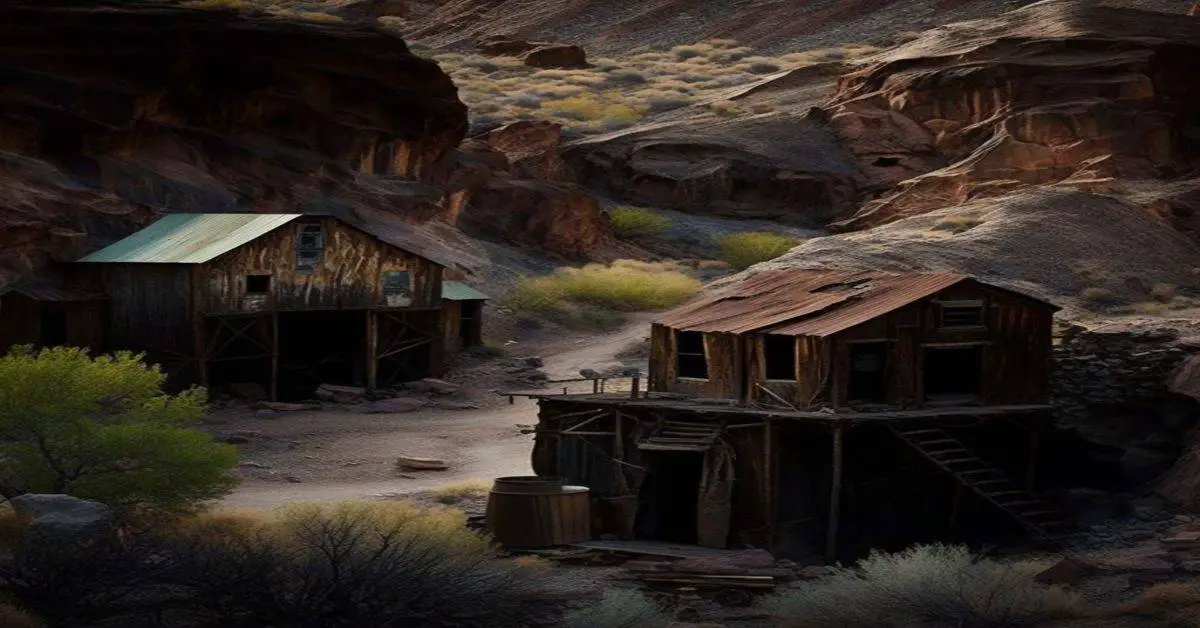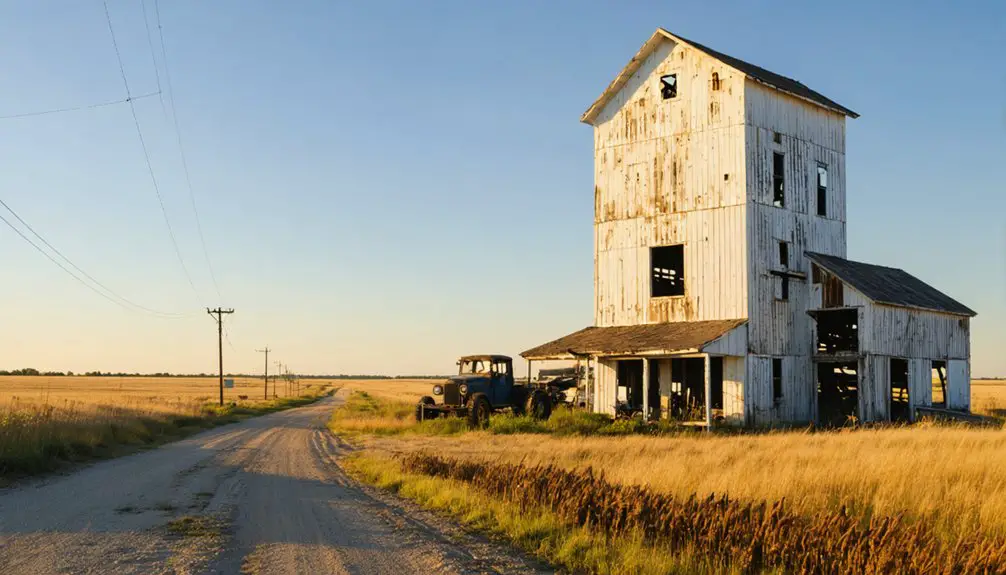You’ll find Temvik, North Dakota along U.S. Route 83, established in 1904 as Godkin before changing names twice more. This former agricultural hub, named after the Tempel brothers who platted the townsite, once bustled with grain elevators, a flour mill, and the Patterson Hotel. The town’s decline began with agricultural mechanization, leading to its abandonment after 1968’s postal closure. Temvik’s architectural remnants tell a fascinating story of prairie ambition and harsh realities.
Key Takeaways
- Temvik was established in 1904 as a railroad town in Emmons County, North Dakota, reaching a peak population of about 200 residents.
- The town changed names from Godkin to Brophy to Larvik before finally becoming Temvik in 1911, named after the Tempel brothers.
- Agricultural infrastructure included grain elevators, a flour mill, and lumberyards, with the economy centered around farming and railroad shipping.
- The town’s decline began with agricultural mechanization, leading to population loss and eventual closure of postal services in 1968.
- Today, Temvik stands as one of North Dakota’s ghost towns, with only architectural remnants and a maintained cemetery marking its existence.
The Origins of a Prairie Settlement
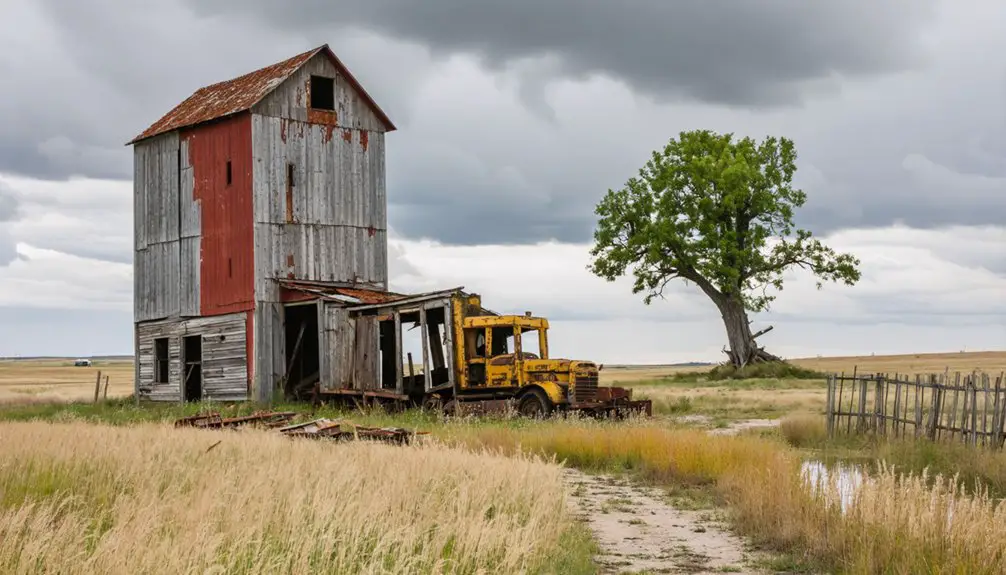
While many prairie settlements emerged during North Dakota’s early development, Temvik’s story began in 1904 when it was first established as Godkin between the towns of Linton and Hazelton in Emmons County.
The settlement patterns took shape in 1908 when the Tempel brothers purchased land and platted the townsite, establishing critical businesses that would define the community’s character.
The town’s identity emerged from complex community dynamics, as residents sought to honor the Tempel family while steering through naming conflicts with existing settlements.
You’ll find that Temvik’s name itself represents a creative solution – a combination of “Tempel” and “Larvik.”
The strategic location along U.S. Route 83 proved essential for the town’s early growth, supporting the development of fundamental infrastructure including a lumberyard, grain elevators, and a flour mill.
From Godkin to Temvik: A Town’s Many Names
As small prairie settlements often struggled to establish their identities in early North Dakota, Temvik‘s journey through multiple name changes reflects the complex dynamics of frontier town development.
You’ll find the town’s name evolution began in 1904 as Godkin, before changing to Brophy after a local store owner. By 1908, it became Larvik, while a competing settlement called Templeton emerged nearby.
The community’s identity took its final form through an interesting merger conflict. When postal officials rejected “Union City” as the combined name, a creative solution emerged. A local schoolteacher suggested “Temvik” – blending “Tem” from the influential Tempel brothers with “vik” from Larvik.
This distinctive name became official in 1911 when the post office adopted it.
Life in Early 20th Century Temvik
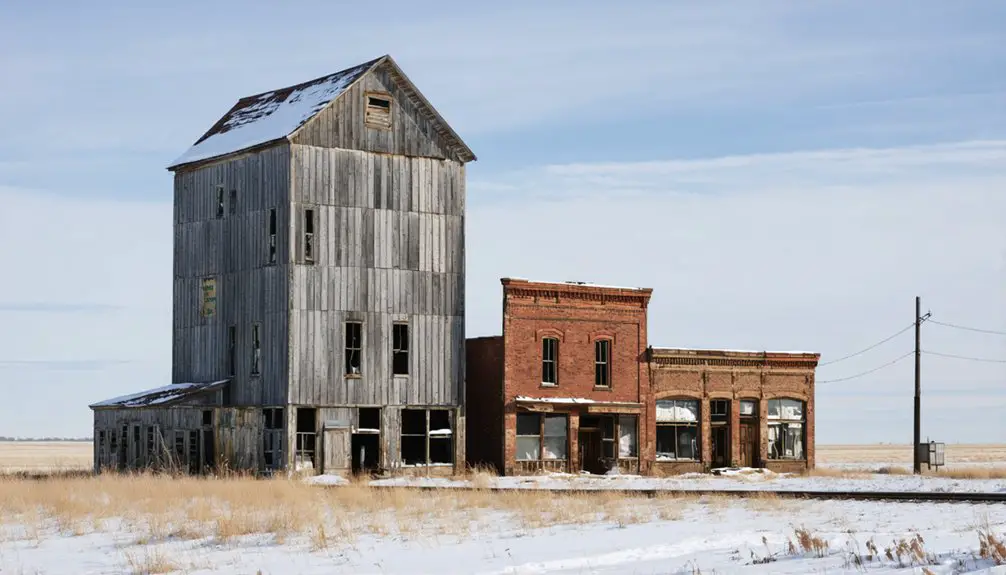
During the early 1900s, Temvik evolved from a simple railroad siding into a bustling prairie community of roughly 200 residents.
You’d have found strong community resilience in this small town, where the Patterson Hotel served as a social hub while churches fostered social cohesion among settlers.
The town’s infrastructure included a school for local children, a courthouse for governance, and a post office that connected residents to the wider world.
Essential public institutions anchored daily life in Temvik, from education and local government to vital postal connections.
You could’ve witnessed the economic pulse of Temvik through its grain elevators and the Farmer’s Friend Milling Company, though these enterprises faced challenges during the 1918 influenza epidemic.
Despite lacking a local doctor, the mainly Scandinavian-influenced population maintained their agricultural way of life, supported by the railroad’s essential connection to markets beyond the prairie.
Agricultural Heritage and Economic Activities
You’ll find that Temvik’s economic heart centered around its grain elevators, which served as essential collection and shipping points along the Northern Pacific Railroad starting in 1902.
Local farmers worked diversified operations that grew beyond wheat to include oats, durum, barley, flax, sugar beets, corn, and sunflowers while also raising beef cattle to strengthen their economic resilience.
The town’s agricultural infrastructure expanded to support these farming activities, with lumberyards and other agriculture-related businesses emerging to serve the growing community’s needs.
Grain Elevators and Commerce
Three prominent grain elevators once defined Temvik’s skyline, serving as the economic backbone of this early 1900s North Dakota settlement.
You’ll find the elevator economics were closely tied to the Northern Pacific Railroad siding, which enabled local farmers to connect their harvests with broader markets. The Tempel brothers recognized this potential in 1908, constructing one of the town’s crucial grain storage facilities.
These elevators, typically holding 25,000-30,000 bushels, weren’t just storage buildings – they were your gateway to commercial success. Like many North Dakota facilities of the era, they were part of a network of 2,000 grain elevators operating across the state.
Whether operated by regional grain companies or farmers’ cooperatives, they stimulated auxiliary businesses and established Temvik as a commercial hub.
The 1943 fire that destroyed a major elevator marked a turning point, highlighting how these structures were fundamental to the town’s survival.
Farm Operations and Land
As North Dakota’s agricultural landscape flourished in the early 1900s, Temvik’s farmers contributed to an impressive expansion that saw 45,000 farms spread across 15.5 million acres statewide.
You’d find their fields filled with diverse crops – from durum wheat and winter rye to flax and alfalfa – requiring careful farm management to balance costs against uncertain profits.
Despite systematic approaches to farming, you couldn’t escape the challenges of rising land values and mortgage costs.
Crop diversification became your lifeline when wheat yields declined and soil health deteriorated. You’d likely have turned to livestock operations to stabilize your income, while experimenting with new farming techniques to combat “wheat sick” land conditions.
The combination of mixed farming practices and strategic crop rotation offered hope for sustainable yields in these challenging times.
The Path to Abandonment
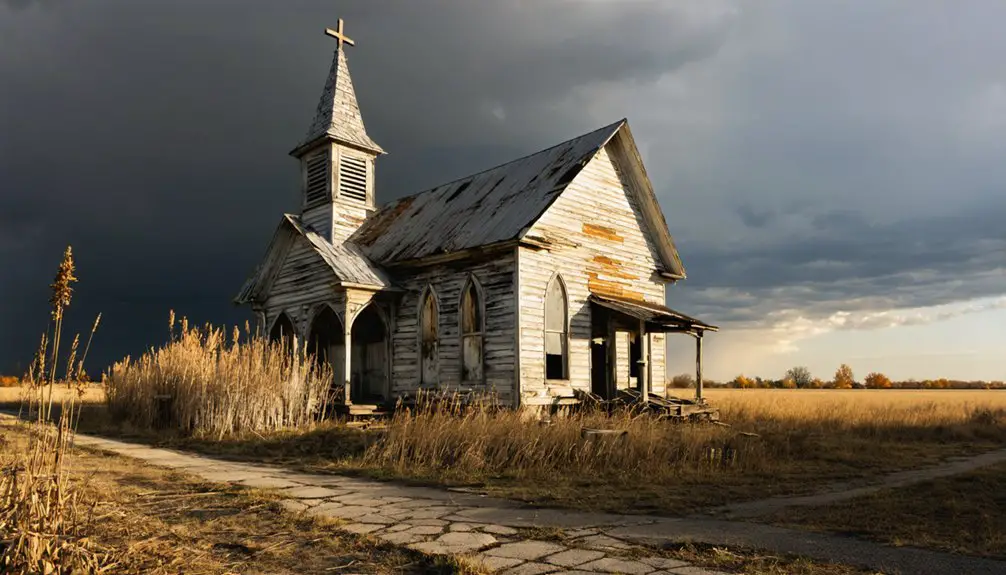
While Temvik initially showed promise as a small farming community in the early 1900s, its path toward abandonment began gradually through the mid-20th century.
You’ll find that population migration away from the town accelerated as agricultural mechanization reduced the need for farm labor. Former residents’ stories contribute valuable historical accounts of these vanishing communities, much like the reader comments that preserve memories of other ghost towns. The closure of the postal service in 1968 dealt a significant blow, forcing residents to rely on Linton for basic services.
The town’s decline mirrored the fate of many small North Dakota communities established during the same era. Harsh winters, limited transportation infrastructure, and the absence of economic diversification made it increasingly difficult to sustain a viable community. Today, like many true ghost towns in North Dakota, the site lacks any visible remnants of its past community structures.
Preserving Temvik’s Legacy Today
Despite Temvik’s physical decline, dedicated efforts continue to preserve its rich historical legacy through multiple channels.
You’ll find its stories safeguarded in county courthouses, the North Dakota Historical Society archives, and through digital storytelling initiatives on platforms like Digital Horizons, which hosts thorough town histories and photographs.
Community engagement thrives through educational field trips, public presentations, and heritage events that bring Temvik’s past to life.
The town’s cemetery stands as a lasting physical reminder, carefully maintained to protect its cultural significance.
Local historians capture oral histories from settlers’ descendants, while digital preservation efforts include podcasts, online databases, and social media channels.
Through these diverse preservation methods, you’re able to explore and connect with Temvik’s fascinating history, even as its physical presence fades into the prairie.
Ghost Towns of the Northern Plains
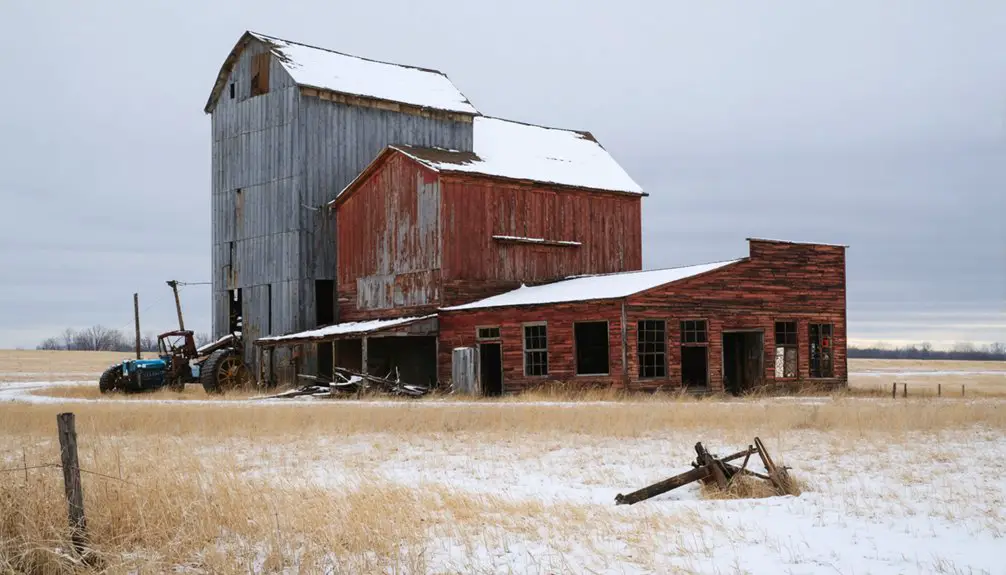
Across the Northern Plains, you’ll find hundreds of ghost towns like Temvik that tell a common story of railroad-driven settlement followed by agricultural decline and eventual abandonment.
These prairie communities once bustled with grain elevators, general stores, and social halls that served as lifelines for rural families working the surrounding farmland.
The architectural remains you see today – from weathered wooden storefronts to crumbling grain elevators – stand as silent witnesses to the boom-and-bust cycles that shaped settlement patterns across North Dakota and its neighboring states. The Dust Bowl era triggered widespread abandonment of farming communities across the Great Plains.
Prairie Town Life Patterns
Throughout the late 19th and early 20th centuries, prairie towns dotted the Northern Plains landscape as essential centers of commerce and community life.
You’d find these settlements clustered around railroad lines, where community gatherings at post offices and general stores created vibrant social hubs for farmers and merchants alike. One such example was when the Northern Pacific Railroad built large section-houses to support maintenance crews that kept the rail lines operational. Deep ditches along dirt roads provided rainwater management for these bustling communities.
Life in these towns revolved around three key elements:
- Railroad commerce driving local economies through grain elevators and hotels
- Essential services like blacksmiths, banks, and post offices serving rural populations
- Agricultural trade supporting “mom and pop” stores and seasonal workers
As transportation shifts favored automobiles in the 1920s and farming became increasingly mechanized, these once-thriving communities began to fade.
The drought of 1936 accelerated their decline, forcing many residents to seek opportunities elsewhere as services and businesses gradually disappeared.
Railroad Settlement Stories
When railroad companies carved their paths across the Northern Plains in the early 1900s, they established a network of small settlements that would serve as crucial logistical hubs along their routes.
The Milwaukee line passed through this region, establishing new settlements along its route.
You’ll find that railroad expansion brought more than just tracks – it created entire communities designed around the rhythms of train schedules and agricultural shipments.
These settlements emerged as crucial links in the region’s transportation network, with each stop carefully positioned to serve local farmers and railroad operations.
You’d have seen telegraph offices, stockyards, and grain elevators rising from the prairie, marking these new communities.
Many of these towns became boomtowns that rapidly declined when economic conditions changed, following a pattern seen throughout American railroad history.
Settlement dynamics centered on practical needs – towns needed enough residents to operate crucial services while maintaining the railroad’s infrastructure.
Most communities remained small, with populations rarely exceeding 100 people, primarily railroad workers and those supporting agricultural operations.
Abandoned Plains Architecture
The architectural remnants of abandoned Plains towns tell a compelling story of frontier ambition and harsh realities. Walking through Temvik’s weathered structures, you’ll witness the distinctive prairie aesthetics that defined these settlements – from false-front commercial buildings to sturdy grain elevators positioned strategically near former rail lines.
These abandoned architecture sites reveal three key features of Plains town planning:
- Buildings clustered near transportation routes, determining their fate when railways shifted
- Construction adapted to local conditions with drainage systems and elevated foundations
- Utilitarian designs using local materials like wood and brick, reflecting both economic prosperity and environmental challenges
What remains today are foundational ruins and empty storefronts, silent testimonies to the boom-and-bust cycle that shaped the Northern Plains frontier experience.
Frequently Asked Questions
Are There Any Documented Paranormal Activities or Ghost Stories From Temvik?
As silent as an empty grave, you won’t find documented ghost sightings or local legends from this place. Research and historical records show no confirmed paranormal activities or haunting tales here.
What Happened to the Original Buildings and Homes of Temvik Residents?
You’ll find most buildings were demolished or decayed naturally after abandonment, with residents relocating nearby. Abandoned structures vanished as farmland took over, leaving no original homes standing except cemetery remnants.
Who Was the Last Person to Leave Temvik?
Like a pioneer’s fading footprints in the prairie dust, you won’t find records naming the last resident. Town history suggests the final inhabitant likely departed around 1968 when the post office closed.
How Many People Are Buried in the Temvik Cemetery?
Based on cemetery records, you’ll find 242 documented burials, though burial customs suggest there may be around 30 additional unmarked graves with steel crosses or no markers at all.
Do Any Descendants of Original Temvik Settlers Still Live Nearby?
Farming families and distant descendants do persist in the surrounding prairie, though you’ll find local connections are sparse. Records suggest some settlers’ families maintain scattered homesteads near the former town site.
References
- https://en.wikipedia.org/wiki/Temvik
- https://www.loquis.com/en/loquis/6780137/Temvik+North+Dakota
- https://northernsentry.com/2025/06/26/north-dakota-ghost-towns/
- https://northernsentry.com/2023/05/12/ghosts-of-north-dakota/
- https://ghostsofnorthdakota892857007.wordpress.com/2015/10/30/true-ghost-towns-population-zero/
- https://news.prairiepublic.org/main-street/2019-05-09/naming-temvik
- http://theusgenweb.org/nd/emmons/historycounty1976.pdf
- https://www.nd.gov/government/state-government/county-history
- https://search.worldcat.org/title/The-History-of-Temvik-ND/oclc/21898539
- http://theusgenweb.org/nd/emmons/historytemvik.htm

